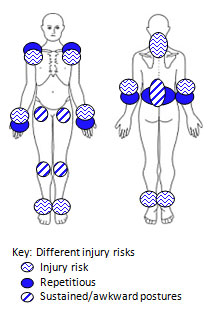Demolition worker
Demolition workers demolish, dismantle and remove building structures and materials including brick, timber, concrete and metal.
Tasks and tools used
- erecting screens, dustsheets, temporary fencing and safety barricades around sites and areas of demolition
- sealing drains as required
- spotting for hazards
- hosing to reduce dust during demolition sometimes required
- manual labouring to disassemble and strip building structures such as doors, windows, pipes, radiators and light fixtures
- sorting and stacking materials for removal from site or to reuse which can require lifting, moving and handling materials of varying sizes and shapesw
- working at heights can be required via scissor lifts or booms or climbing scaffolding or temporary work platforms and part building structures
- negotiating uneven ground or surfaces
- air compressor guns used to knock down walls
- jackhammers used to break up concrete and brick structures
- wrecking bars, sledgehammers, axes, shovels can be used to demolish smaller wooden structures
- power tools such as grinders, demolition saws, drill can be used
- oxyacetylene torches used for cutting steel
- jimmy bars, crow bars, spanners and hand tools used at various times
- front-end machine operators pick up and move debris and building materials
Personal protective equipment
- gloves
- hard hat
- mask
- visibility vest
- trousers
- safety boots
- ear muffs/plugs
- safety glasses
- sunscreen
Risks – potential musculoskeletal injuries

Heavy risk
- Wrist, forearm and elbow strain: Repetitive tasks such as gripping involving the wrist and forearm increase risk of repetitive stress injuries.
- Lumbar muscle non-specific strain: Prolonged forward bending/stooping.
- Cervical joints non-specific: Prolonged neck extension or flexion whilst working in awkward positions.
- Shoulder joint complex impingement/strain: Forceful and repetitive movements of upper limbs.
Medium risk
- Thoracic spine non-specific: Repetitive trunk rotation with variable load.
- Knee joint sprain/strain: Prolonged squatting or weight bearing on knee joint.
Light risk
- Hip joint inflammation: Hip flexor tightness due to prolonged squatting.
- Ankle sprains/strains: Constant inversion/eversion movements to counteract uneven and unstable surfaces.
Critical physical job demands and other task requirements
Critical job demand descriptor | % of time the task is performed | Task |
|---|---|---|
| Constant | >66% |
|
| Frequent | 34%–66% |
|
| Occasional | 5%–33% |
|
Suitable duties
- goals must be clear, realistic and achievable
- must have 'buy-in' from the worker
- worker helps to set the goals, and must be answerable if goals are not met (this allows barriers to RTW to be identified at an early stage and obstacles overcome)
- workers need to understand they have an obligation to participate in rehabilitation and RTW as per Section 232 of the Workers' Compensation and Rehabilitation Act 2003 (the Act).
Return to work suggestions
Worker can begin with light duties and include more tasks as their capacity for work changes. We'll work with all parties, including the treating medical provider, employer and worker to ensure everyone is aware of where the worker is with their rehabilitation and stay at, or return to work.
Note: some tasks are dependent on worker's injury and capacity, and some tasks may require the assistance of a co-worker.
Offsite
If the worker needs to take a break from work, they're rehabilitation can still begin at home. Tasks can include:
- video on safety issues can be viewed (lying in bed if injury type requires)
- computer-based programs, CDs or DVD on work-related subjects
- phone-based work
- emails
- training
- other worksite inductions
- checking or auditing paperwork, e.g. helping the WHSO audit lost time injuries (LTIs) for a six-month period.
Host employment
In the event an employer is unable to provide suitable duties, a host placement may be required. If this is the case, the worker may be placed at a different employer in a graduated return to work plan until they're able to 'upgrade' back to his/her pre-injury role with their pre-injury employer.
WorkCover Queensland's Recover at Work program places injured workers in short term host employment with employers who have an established track record of successful return to work outcomes with their own workers.
More return to work resources
- View physical demands photos for Demolition worker